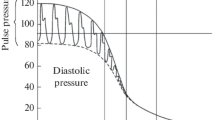Abstract
An investigation of the feasibility and validity of measurement of the conjunctival oxygen tension as a monitor of peripheral circulation, blood and extracellular fluid volume and cerebral circulation was carried out in 7 healthy volunteers and 5 unconscious critical care patients with proven total cerebral infarction. The healthy volunteers were subjected to changes in hydration achieved by the administration of furosemide and subsequent rehydration by administration of normal saline. Conjunctival oxygen tension was found to be a sensitive indicator of changes in the degree of hydration presumably by its ability to detect changes in peripheral circulation depending upon circulating blood and extracellular fluid volume. A drawback is that other stimuli of the sympatho-adrenergic system such as temperature and pain, interfere with measurement in the conscious volunteer. In patients with presumed total brain infarction the conjunctival PO2 cannot be used as a reliable monitor of cerebral blood flow because of varying perfusion of the palpebral conjunctiva from the external carotid artery in the occasional patient.
Similar content being viewed by others
References
Fenner A, Mueller R, Busse HG, Junge M, Wolfsdorf J. Transcutaneous determination of arterial oxygen tension. Pediatrics 1975; 55: 224–31.
Rooth G, Hedstrand U, Tydén H, Ögren C. The validity of the transcutaneous oxygen tension method in adults. Crit Care Med 1976; 4: 162–5.
Isenberg SJ, Shoemaker WC. The transconjunctival oxygen monitor. Am J Ophthalmol 1983; 95: 803–6.
Shoemaker WC, Lawner PM. Method for continuous conjunctival oxygen monitoring during carotid artery surgery. Crit Care Med 1983; 11: 946–7.
Ninikoski J. Tissue oxygenation in hypovolemic shock. Ann Clin Res 1977; 9: 151–6.
Tremper KK, Waxman K, Bowman R et al. Continuous transcutaneous oxygen monitoring during respiratory failure, cardiac decompensation, cardiac arrest, and CPR. Crit Care Med 1980; 8: 377–81.
Tremper KK, Shoemaker WC. Transcutaneous oxygen monitoring of critically ill adults, with and without low flow shock. Crit Care Med 1981; 9: 706–9.
Abraham E, Dye RK, Smith M. Detection of blood volume deficits through conjunctival oxygen tension monitoring. Crit Care Med 1984; 12: 931–4.
Abraham E, Smith M, Silver L. Conjunctival and transcutaneous oxygen monitoring during cardiac arrest and cardiopulmonary resuscitation. Crit Care Med 1984; 12: 419–21.
Sjöström PA, Odlind BG, Beerman BA, Hammerström-Udencaes M. On the mechanism of acute tolerance to furosemide diuresis. Scand J Urol Nephrol 1988; 22: 133–40.
van der Linden J, Modig J, Wiklund L. Conjunctival oxygen tension monitoring in experimental septic shock. Int J Clin Monit Comput 1989; 6: 37–43.
Nisam M, Albertson TE, Panacek E, Rutherford W, Fisher CJ. Effects of hyperventilation on conjunctival oxygen tension in humans. Crit Care Med 1986; 14: 12–5.
Guerci AD, Thomas K, Hess D, Halperin HR, Tsitlik JE, Wurmb E et al. Correlation of transconjunctival PO2 with cerebral oxygen delivery during cardiopulmonary resuscitation in dogs. Crit Care Med 1988; 16: 612–4.
Author information
Authors and Affiliations
Rights and permissions
About this article
Cite this article
Sjöström, P., Wiklund, L. & Odlind, B. Conjunctival oxygen tension is influenced by plasma and blood volume, and flow through the external carotid artery. J Clin Monit Comput 11, 99–103 (1994). https://doi.org/10.1007/BF01259559
Accepted:
Issue Date:
DOI: https://doi.org/10.1007/BF01259559




